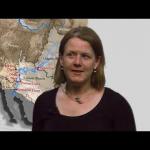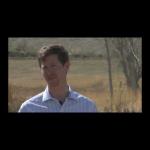
What Does the Future Hold?
In the final video lecture of the series, Eric Gordon and Anne Gold from CIRES wrap up the series by giving an overview of the previous lectures and discussing possibilities of future challenges facing water in the west.

Physical Attributes of the Colorado River and Experimental Flows in the Grand Canyon
This lecture by Dr. Jack Schmidt from Utah State University gives an overview on the physical attributes of the Colorado River and how that affects river restoration. This video is part of the Water in the Western US lecture series.

The Colorado River Basin Water Supply and Demand Study
In this lecture, Dr. Ken Novak from the US Bureau of Reclamation examines a case study on the water supply and demand of the Colorado River Basin. Learn about how increasing demand for water affects reservoirs and other infrastructure. This is part of the Water in the Western US lecture series.

Climate and the Colorado River Basin Past, Present, and Future
This video features Jeff Lukas from CIRES' Western Water Assessment who discusses the overall climate patterns of the Colorado River Basin, and how we can use this information to study the past, present, and future climate of the western United States. This video is part of the Water in the Western US lecture series.

History of Development of the Colorado River Basin
In this video, Dr. Paul Lander from the University of Colorado Boulder gives a lecture on the history of two important dams: Hoover and Glen Canyon. This is part of the Water in the Western US lecture series.

Geographic and Physical Overview of the Colorado River Basin
CIRES' Anne Gold delivers a lecture on the physical geographic overview of the Colorado River Basin and the legal and political aspects of water management in the west. This is part of the Water in the Western US lecture series.

Impacts of Climate Change in the Interior West
This video features Eric Gordon, who delivers a lecture on the effects that climate change will have on water in the Western United States. This is part of the Water in the Western US lecture series.

River and Flash Flooding
Research scientist Dr. Kelly Mahoney explores rivers and flash flooding in the west. This video covers different kinds of floods, what causes flash flooding, why flash flooding is more of a risk in the Western US, and what happened in the 2013 Front Range floods. This video is part of the Water in the Western US lecture series.

Prior Appropriation
In this video, Assistant Attorney General Kate Ryan from the Colorado Supreme Court gives an overview of water rights across the Western US and the Prior Appropriation Doctrine. Learn why this doctrine is important for learning about water in the west. This video is part of the Water in the Western US project.

Why Study Water in the West?
This video serves as an introduction to the Water in the Western US lecture series. The instructors Dr. Anne Gold and Eric Gordon explain the importance of learning about water in the Western United States.

Controlling the Flow of the Colorado River
Students will learn about the Colorado River and human efforts to control water flow. Students will then research other water management efforts throughout the country and report their findings.

Sharing a River - The Colorado River Story
In Lab 4, students take a journey to the Colorado River Basin near Lees Ferry. They explore aspects of the Colorado River Basin using a variety of resources, interactive maps, and tools such as Google Maps. This journey give them perspective on the scope of the watershed and how various stakeholders have siphoned the water from the river to serve…

Arizona and the Colorado River
In this activity, students will learn about the dams and major cities on the Colorado River. They will research why the dams were built and discuss how hydrology plays such a great part in the geography of Arizona. This lesson has strategies for diverse learners (ELLs).

The Colorado River Water Story
The Colorado River watershed has always been a subject of great interest and concern. It provides agricultural irrigation and drinking water to farms and cities in seven southwestern states. The intention of this exercise is to be a southwestern regional perspective of a changing climate. You’ll be graphing snowpack in the Colorado Rocky Mountains…

Hoover Dam and Hydroelectric Power
Since its completion, Hoover Dam has wowed visitors with its sheer massiveness and its ability to create and hold back a reservoir that covers nearly 650 square kilometers (250 square miles). Yet, perhaps even more impressive is the dam's ability to harness the potential energy stored in the reservoir and convert it to electricity. In this video…

Drought in the Colorado River Basin
This application was developed by the U.S. Geological Survey and the Bureau of Reclamation in support of the Department of the Interior’s Open Water Data Initiative (OWDI). This visualization is part of a multi-agency effort to showcase the usefulness of open data (i.e., data provided in a discoverable, sharable, and machine-readable…

The Hardest Working River in the West
This is a StoryMap on the Colorado River. The story map details the history of the Colorado River, water resources, river management, and tools for managing in the future.

Water: A Zero Sum Game
This video takes viewers high into the Rocky Mountain snowpack, where researchers dig snow pits to explore the source of Colorado's water supply. Highlights the importance of snowpack on the supply of fresh water available in western and southwestern states. Snowmelt dynamics are discussed, including the impact of a warming climate. Video length…

Colorado River water supply
This activity addresses climate change impacts that affect all states that are part of the Colorado River Basin and are dependent on its water. Students examine available data, the possible consequences of changes to various user groups, and suggest solutions to adapt to these changes. Activity takes about one-two class periods and homework…